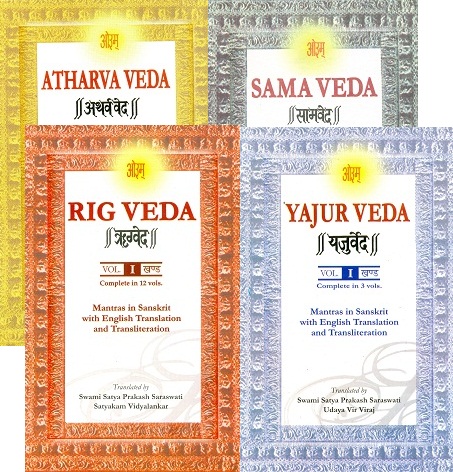Vedas Pdf In English

The word Veda means knowledge, derived from the root 'vid' from which four meanings can be described 'knowledge', 'existing', 'beneficial' and 'thought'. They were revealed to four Rishis (Rsis) named 'Agni', 'Vaayu', 'Aaditya' and 'Angiraa' by the God at the onset of the God's best creation - the Mankind. Patanjali, the author of Yoga-Darshana declares that God is the original teacher for the mankind - 'sa purvesamapi guruh kalenanavacchedat'. Badarayana says 'tattu samanvayat'; that is to say, Vedas must be God's revelations because all they contain tally well with the creation. Vedas are also called Shruti or Samhita. The Vedas are composed of Mantras. The mantra, composed in a metre, bears a concept and teaching worth contemplation and adoption.
4 Vedas in Hindi, Gujarati and English pdf By Manthan Kanani June 14, 2018 Books, Mythology, Uncategorized, vedas 0 Comments All of four Vedas with authentic commentaries according to vedic tradition of the nirukta and nighantu grammar of vedic sanskrit are available here in Hindi and English both languages.
It contains true knowledge, and inspires noble thought and action. There is nothing in the Vedas that is contrary to what is seen in nature.
Over and beyond what we know today, the Vedas may contain many more revelations that we might not be even aware of today. Vedas contain knowledge about both matter and spirit.
4 Vedas In English
The knowledge about matter is in seed form leaving ample room for man to discover further and create his own body of literature. On the other hand, the knowledge pertaining to spirit is at its pinnacle that man will never be able to add anything to that body of knowledge. Till about more than 5000 years ago, Sanskrit was the most prominent language. Learned people like Lord Krishna and Ved Vyaas contributed to literature that contained the essense of the Vedas.
However, the downfall of the Brahmin (faculty) community had already started then. With the war of Mahabharat and other events, Lord Krishna was able to unite India and uplift the Khstriya (administration) community which lasted well for next 3000 years; till whence India saw its first invasion with Alexander. But for 3000 years the downfall of the Brahmin community continued to impact all other communities, viz; Khstriya (administration), Vaishya (commerce) and Sudra (service). Sanskrit started to become the propriety of the Brahmins.
Vedas Pdf Download
The communities started to become by birth and not by action which they follow. The brahmins had started to undermean the Vedas for there personal benefits and supremacy and in the process the true essence of the Vedas was lost. Sanskrit started being replaced with local languages like Tamil, Pali, Prakrit, etc. To compete with the advent / invasion of various faiths there after like Buddhism, Jainism, Christianity, Islam, Sikhism, Sufism, etc; the Brahmins in the last 2000 years further worked out various literature like Puranas, Bhaagvat (not Bhagvat Gita), etc on containing stories on things that looked great and out of the world but were opposed to the natural and spiritual sciences. The meaning of Vedas were further lost to these scriptures. Then, everything in Sanskrit became as sacred as the Vedas and anything said by the brahmin became as sacred as Vedas even if the Brahmin knew absolutely nothing of the Vedas. In the last 1000 years, Muslims killed the learned people, burnt the sacred books and plundered the places of learnings and temples.
The Missionary propaganists in their zeal for conversion, in their anxiety to show the superiority of the Christian Bible, condemned the Vedas in the most positive language at their command. For this purpose they even transgressed the rules of fair honest controversy by quoting the conclusions of Euorpean Scholars on Vedic Religion and Vedic Culture without accompanying qualifications, and without giving th reader any idea of the unsatisfactory character of the translations on which these conclusions were based, though well known to and acknowledged by themselves. The Vedas were revealed to the earliest noble rishis and traditionally handed down to posterity. Since they were revealed in the beginning of creation, that is, prior to human history, no historical or geaographical references can be sought for in the Vedic texts. As such the question of historical or geographical references to any particular country or the people inhabiting it does not arise.
The Vedas were given to us when there were neither any territorial or political divisions and nor any proper names were given to particular lands, mountains, rivers or seas. All men belonged to a common world, and they stood for universal fraternity for whom the whole world was one family - 'Vasudhaiv Kutumbkam'. It was centuries, or may be, millenia afterwards that the lands, rivers and mountains etc were given names, borrowed from the Vedic texts. 2) Atharva Ved 1.23.1 says 'Naktam Jaatasyovadhe Rame Krishne Aasakti ch'. Now, Ram of Ramayan and Krishna of the Mahabharat belonged to quite different ages; and both long after the Vedas. These have to be interpreted etymologically in the context in which they occur in the Atharva Veda, which is as a treatise on medicine here.
The verse under consideration deals the treatment of leucoderma (kilaas) and suggests a particular her which is duskly (rama), dark (krishna) and black (asikni) in hue. This medicine is said to recolour the ashy spots.
Contemporary to Maharshi Dayanand and post that many other Foreign and Indian writers have done translations on the Vedas. The translations to foriegn languages, particularly english, done by the foreign authors are found to be tainted with malicious intent and are worth being considered trash. Indian authors in the last century have also done translations to many languages like English, Hindi, Bengali, Tamil, Gujarati, etc. Based on the translation and translation methodology provided by the above authors, particularly by Maharshi Dayanand.